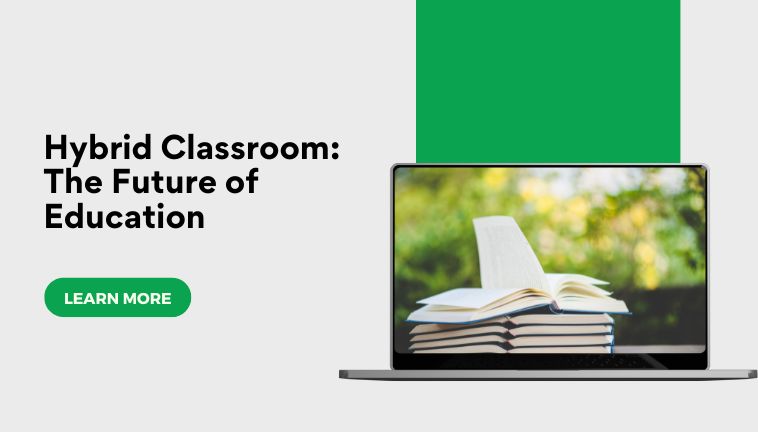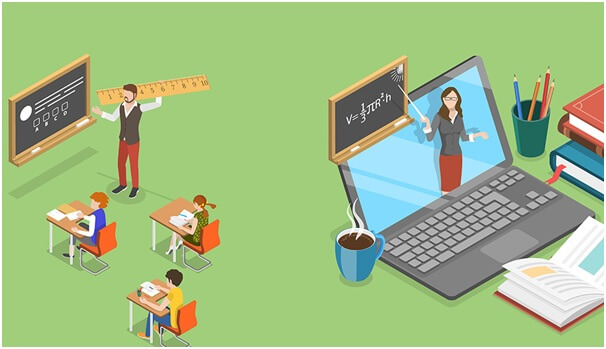Blogs
Hybrid Classrooms: The Future of Education
Published on: October 7, 2024
Author:
SchoolnetIndia

As a teacher, you're skilled in traditional teaching methods. But with the world changing fast, a new approach can boost how you teach. Have you heard of hybrid classrooms?
It may sound like just another trend, but we promise, it’s becoming the future of education. Let’s break it down for you in a simple way. Keep reading!

What is a Hybrid Classroom?
A hybrid classroom blends traditional in-person teaching with online elements. Picture this: some of your students are in the classroom, while others join from home or another location through technology. It’s not just about adding a Zoom call to your lesson plan; it’s a balanced approach where in-person and online students get the same learning experience. The idea of a hybrid classroom is more than just convenience. It’s about offering flexibility in teaching methods, catering to different learning styles, and making education accessible to more students. Whether they’re physically there or joining online, the experience should feel seamless.
What makes Hybrid Classrooms more appealing in the 21st century?
You might be asking, "Why change from the traditional methods that have worked well so far?" That’s a valid question, and we understand! But here’s why hybrid learning is quickly becoming the norm and why you might want to give it a try:1. Flexibility for Students and Teachers
In a hybrid classroom, students can learn from anywhere, which is crucial when attending school in person isn’t possible. Think of times when students are sick, face transportation issues, or during events like a pandemic. Hybrid education allows them to keep learning without falling behind. For teachers, this model offers flexibility in lesson delivery. You can combine traditional teaching with modern tech. Some lessons may work better in person, while others may benefit from digital tools like simulations, quizzes, or pre-recorded videos. Schoolnet’s hybrid classroom makes it easy for you to edit and adjust lessons to meet students’ needs.2. Better Student Engagement
Traditional classrooms often struggle to keep every student engaged. Some students are visual learners, others learn by listening, and some do best in interactive settings. Hybrid classrooms let you meet these needs. Online tools, like quizzes and animations, can help students who may not respond as well to lectures. Hybrid classes also encourage participation in new ways. Tools like polls, chats, and breakout rooms let quieter students contribute without the pressure of speaking in front of everyone. This approach fosters a more inclusive learning environment where all students can thrive.3. Real-World Preparedness
Think about the world your students will enter after school. Many workplaces now use a mix of in-person and virtual communication, especially with the rise of remote work. By using a hybrid classroom, you’re preparing students for real-life situations where they’ll need to collaborate both face-to-face and online. You’re not just teaching academics you’re building the digital skills they’ll need for future careers.4. Personalized Learning
One of the best parts of hybrid learning is the ability to personalize lessons. In a traditional class, it’s hard to meet every student’s individual needs. With a hybrid model, you can create tailored learning paths using technology. You can provide extra resources for students who need more help or offer advanced materials to those ready to move ahead. Platforms like Roombr allow students to access lessons anytime, anywhere. Online systems can also adjust the difficulty of tasks based on student performance, making sure every learner is challenged at their level. This is much harder to achieve in a traditional classroom setting.What are the operational bottlenecks for Hybrid Classrooms?
Shifting from traditional to hybrid learning does come with challenges. But the benefits far outweigh the hurdles, and with a bit of planning, it's completely doable!1. Technology Access
Some students may not have the right tools at home, like laptops or reliable internet. However, many schools and governments are working hard to provide these resources to close the digital gap.2. Teacher Training
Adapting to hybrid learning means teachers need to get comfortable with new technology. While it may seem overwhelming at first, there are many training programs available. Once you learn the basics, you'll see how technology can make your teaching easier.3. Time Management
Handling both online and in-person students might feel like managing two different tasks. But with Roombr Digital Classroom, you can manage both together, making the process smoother than you might think.How to get started with Hybrid Classrooms?
If you're ready to try hybrid learning, here’s a simple roadmap to get you started:1. Choose Your Platform
Start by selecting a platform that supports both in-person and online teaching. Roombr offers the perfect solution, seamlessly integrating both physical and virtual classrooms.2. Prepare In-Person and Digital Materials
To ensure all students get the same experience, prepare materials for both settings. This could include digital lessons, like recorded lectures or interactive quizzes, alongside physical handouts for students in class.3. Engage Your Students
Keep your lessons interactive for both groups. Use tools like polls, chat features, breakout rooms, and discussion boards to involve all students, whether they’re in class or online.4. Monitor Progress
Track your students' progress by using data from online quizzes, assignments, and participation. This will give you insights into how they're doing and help you adjust lessons to meet their needs. Schoolnet’s hybrid classroom is perfect for hybrid learning because it smoothly combines online and in-person teaching, making education more flexible and accessible. It includes an interactive projector and a large, expandable display that lets teachers deliver engaging lessons in the classroom, while remote students can join online. With built-in AI, Schoolnet improves recorded sessions and gives students 24/7 access to lessons.In Conclusion
We know that moving from a traditional classroom to a hybrid one might feel like a big step, but it’s a change worth exploring. Hybrid education isn’t just a response to current challenges; it’s about preparing your teaching for the future. By combining traditional and modern methods, you can provide your students with a more engaging, flexible, and personalized learning experience.Category:
Blog
Tagged in:
© Schoolnet India Limited





